When Did Jazz Surge in Popularity Again
After more than 100 years of history, it'southward clear the word "jazz" means many different things to many different people. Depending on who's doing the talking, it tin either mean a highly specific musical style, or almost nothing.
The early timeline of jazz is spotty, vague and disputed, as one might expect of a musical movement that grew from a group that was both marginalised and exploited. Jazz evolved from the fringes of American guild into one of the most influential, and enduring, musical movements of the 20th century.
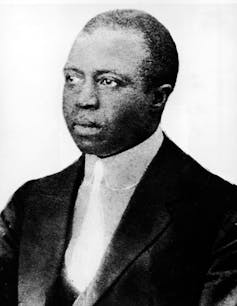
New Orleans in the late 1800s was a remarkably cosmopolitan urban center, with a more than racially egalitarian society than the rest of the American south. In that city, distinct musical trends began to develop, fusing elements of Due west African musical traditions with European harmonic structures. Musicians used readily bachelor military machine band instruments left in pawn shops after the finish of the American Civil War.
Scott Joplin, "the King of Ragtime", popularised a music based on jagged (or "ragged") rhythms, including the habañera, imported from nearby Republic of cuba.
WC Handy, the "Father of the Blues", travelled through Mississippi collecting and publishing folk songs utilising versions of the now standard "blues" grade.
Jelly Roll Morton claimed to accept invented what we telephone call "jazz" in 1902, and did much to popularise the New Orleans sound through newly bachelor recording technologies. Past the fourth dimension he recorded his Black Bottom Stomp in 1926, this new music had travelled as far as Chicago.

In 1917 the cultural hub known as Storyville was airtight, which coincided with The Corking Migration, in which more a million African Americans travelled from rural communities in the Southward to major cities between 1910 and 1930.
That migration, combined with recording technology and Prohibition, brought jazz to an unprecedented number of black and not-black audiences.
During this time Louis Armstrong was at the forefront of jazz. He altered the performance exercise of jazz from the traditional texture in which multiple musicians play melody lines simultaneously, to what we now recognise as the individualist, soloist-plus-ensemble format.
The period between 1935 and 1946, generally referred to as the "Swing Era", saw small, soloist-plus-ensemble bands of Armstrong and others (now called "combos"), largely give way to big bands, consisting of well-nigh eighteen musicians.
Big names from this catamenia, in which "Swing was King", include Duke Ellington (thought of by some as the greatest composer in all of jazz history), Count Basie, Woody Herman, Artie Shaw, Glenn Miller, Tommy Dorsey and Benny Goodman, who was the offset to perform with a racially integrated ring in 1938.
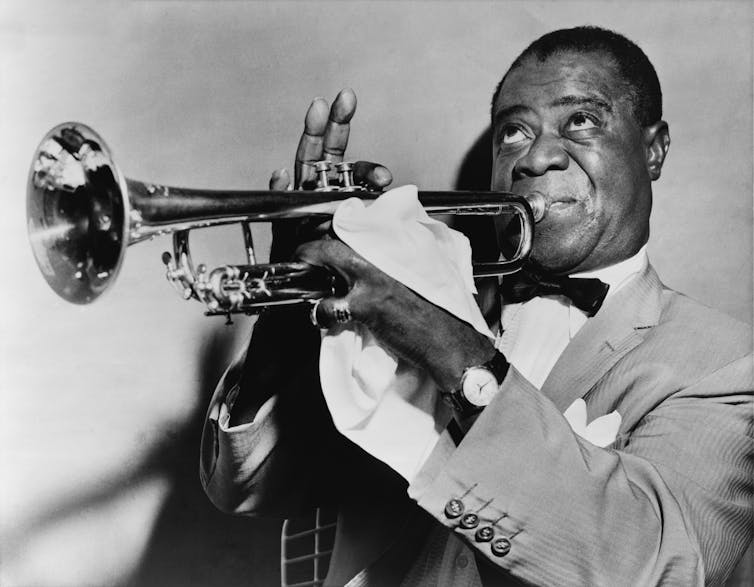
Bebop and the recording ban
In the early 1940s a schism occurred in jazz that forever changed the face of popular music. Many black musicians resented the success of white bands and, led past Charlie Parker and Airheaded Gillespie, returned to the virtuosic combo setting.
"Bebop" was faster and more complicated than annihilation that had come before it. This was the first time jazz audiences sat downward and listened, moving out of the trip the light fantastic toe halls and into smoky bars. Jazz was becoming art music.
Merely every bit bebop musicians were getting the hang of their new ideas, the Musicians Union in the Usa enforced a ban on new commercial recordings equally role of a dispute over royalties.
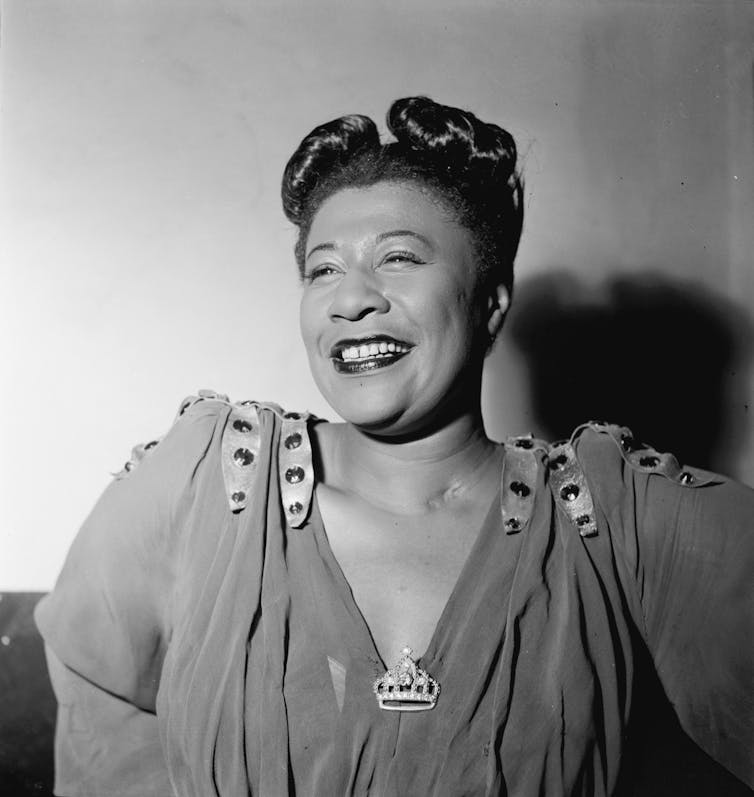
For more a yr, starting in August 1942, nearly no instrumental musicians were permitted to brand new recordings (vocalists were, rather humorously, non considered musicians, and were exempt from the ban).
Interestingly, record labels came up with the idea of recording completely vocal ("a capella") versions of popular songs – think of a baby-faced Frank Sinatra in a sort of period prequel to Pitch Perfect.
Before the ban, vocalists were special soloists with big bands, and usually sang a verse or 2 in the middle of the song. Only Tommy Dorsey's trombone, not Sinatra's voice, was the important feature. During the ban audiences became accustomed to song pop music, and haven't looked back.
From this carve up in the early on 40s between jazz equally art music, and popular music with a vocal focus, the history of jazz follows the fine art branch (the other turning into the history of Rock and Roll in the subsequent 10 years or so).
From Cool Jazz to Hard Bop
Jazz musicians tend not to stay in one genre too long. Out of the rejection of the fast-paced, complex bebop emerged the tardily 40s new Due west Coast scene. Cool Jazz had a more than relaxed tempo, with less focus on soloing and a render to ensemble playing.
Some big names here are Chet Baker, Dave Brubeck, Bill Evans, Gil Evans (no relation), Gerry Mulligan Stan Getz, and even Miles Davis, who would be at the forefront of every innovation in jazz from the 40s, through to his expiry in 1991.
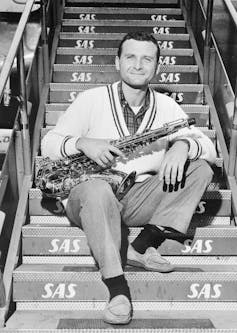
This caused yet another reaction, resulting in what is known as "hard bop", which fuses bebop practices with R&B, Gospel and Blues influences, and is by and large recognised as the default manner practised and taught around the world today.
In 1958, when bebop had taken chord progressions and virtuosity to its farthermost, Miles Davis began experimenting with the other logical extreme. Jazz musicians had been playing the aforementioned standard repertoire since the days of early bebop, and had become very adept at what is called "running the changes".
Nearly songs have similar chord progressions – think of those YouTube videos mashing up dozens of popular hits using the aforementioned iv chords (I V Vi IV progression) – and the same improvised melodies ("licks") can be used over many different songs. Some musicians became frustrated with this apparently mechanical way of improvising, and devised a solution.
Space, melody and free jazz
If bebop had the maximum number of chord changes, what might happen when there were no, or very few, chord changes? Miles Davis' Milestones (1958) has simply 2 chords.
Davis sought to encourage melodic improvising by removing the "crutches" of complex changes. This "Modal Jazz" represented a huge shift in the techniques utilised by soloists, encouraging space in solos.
Compare the beginnings of Davis' solo on And then What with the recordings fabricated by Davis with Charlie Parker a decade earlier.
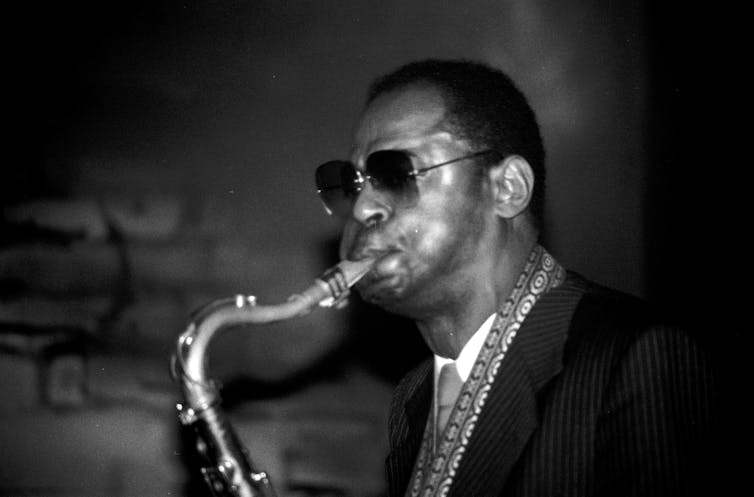
This focus in attention to space and melody, combined with new techniques and ideas coming out of the classical advanced gave rise to advanced, and eventually "costless", jazz. Starting with The Shape of Jazz to Come in 1959, Ornette Coleman did away with chords altogether, encouraging musicians to play without beingness constrained by ideas of Western harmonic and melodic conventions.
This was chop-chop picked up by a number of musicians all over the world (including, perhaps most notably and importantly, John Coltrane, who had recently left Davis' ring), and gave ascent to a wide range of complimentary jazz styles.
These had niggling to do with each other apart from their shared lineage and their involvement in sound, and the unrestricted (or at least, less-restricted) interaction between musicians.
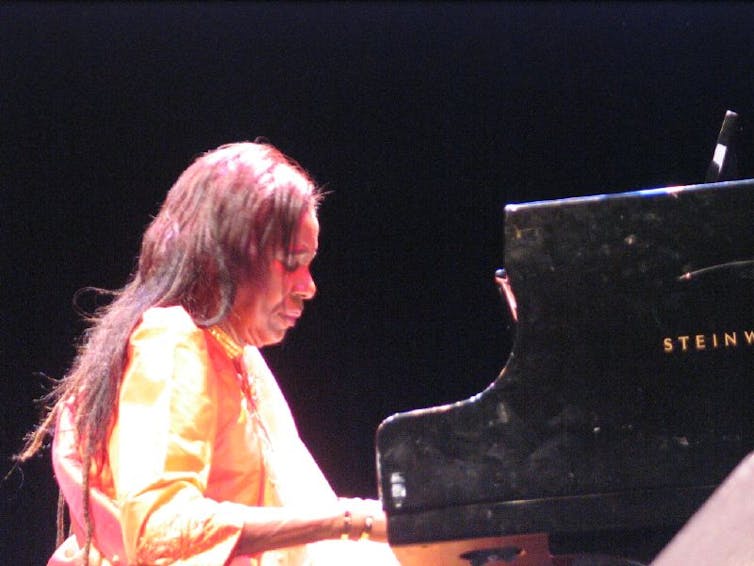
As electronic instruments and funk gained in popularity, jazz musicians quickly jumped on new trends and innovations, starting in 1968 with Miles Davis' Filles de Kilamanjaro.
As jazz moved through the 70s and 80s various elements of pop music seeped in, with just as many jazz elements seeping out – see David Bowie'south Immature Americans (1975), for example.
When speaking of jazz in academia today (jazz theory, jazz aural skills, jazz pianoforte class, etc.), nosotros are using the vocabulary set up out past the pioneers of bebop. Every bit with all musics, in social club to be studied and integrated into didactics, jazz had to be codified, and classicised.
To a jazz musicologist, the give-and-take "jazz" might connote a living, animate tradition encompassing hundreds of musics from dozens of countries, fused with local folk and popular traditions.
But to my grandmother, jazz will e'er exist The Andrews Sisters and that damned Boogie Woogie Bugle Boy.
gallionlostactunce95.blogspot.com
Source: https://theconversation.com/explainer-the-history-of-jazz-51729
0 Response to "When Did Jazz Surge in Popularity Again"
Postar um comentário